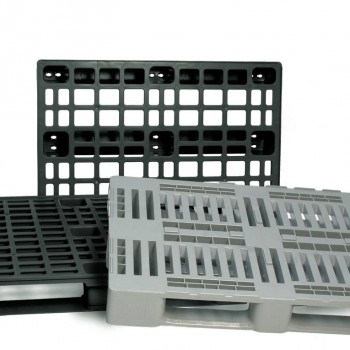Working Safely with Pallets
24 Mar 2014

Pallets are an essential part of many workplaces, allowing heavy loads to be conveniently and safely lifted. However, incorrect use of pallets can result in a range of injuries. Muscle sprains, puncture wounds and blunt trauma can all result from careless use of pallets. As such, it is important to make sure that pallets are used safely and in the proper way.
Inspecting Pallets
Before loading up a pallet, you should perform a quick inspection. It should appear to be in good condition and seem sturdy when tested by hand. It should have no loose or missing parts, no cracks and no protruding splinters or nails. Stringers must also be in good condition. If you are using plastic pallets, some of these points will not be relevant but it is still important to check all that apply.
If a pallet does not meet these conditions, it is not safe to use. It should be repaired or replaced if repair is not practical. Be aware that some companies are producing pallets designed for only one-time use. If you obtain any of these, do not reuse them as they are liable to fail.
Lifting and Handling
Pallets are not designed for lifting by hand. Even multiple men should not attempt to lift a pallet this way. Doing so is liable to result in muscular injury to backs or limbs. Pallets should only be lifted by an appropriate mechanised lifting apparatus.
Obviously, you can be a bit more lenient when it comes to lifting unloaded pallets, but you should still observe precautions. When stacking pallets, never stack more than eight on top of each other by hand, as lifting them any higher could result in injury. When moving empty pallets around, it is safer to stand them on their sides and slide them than to lift them. Always wear gloves when handling pallets, and never throw them as this can injure you or damage the pallet.
Never walk on pallets. They may be able to hold things much heavier than a human, but they are designed to hold evenly distributed loads. This is very different from weight that is focussed on two small human feet. Always walk around pallets, and use a pick hook for accessing products at the back that you can’t reach another way.
Storage
When storing pallets, always lay them down and stack them on top of one another. Never stand them up vertically or lean them against a wall, as this creates a risk of the pallets falling over and causing injury. As mentioned above, they should not be stacked too high by hand. If you wish or need to stack more than eight pallets on top of each other, use a machine.
If you have determined that a pallet is damaged and in need of repair, do not store it alongside other pallets. This will create the risk of them getting mixed up, which could result in a damaged pallet being used by accident. If you do not have a completely separate space to store damaged pallets until they have been repaired, then have a separate stack of damaged pallets and make sure all workers know which stack this is.
